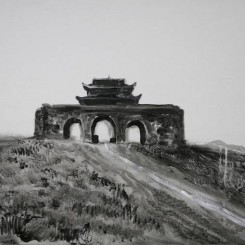Qiu Anxiong is a video, animation and installation artist who lives and works in Shanghai. He was born in Sichuan in 1972 and studied initially at the Sichuan Academy of Art in Chongqing from where he graduated in 1994. Qiu later studied at the Kunsthochschule of the University of Kassel in Germany, graduating in 2003. Chris Moore catches up with him to see what he is up to recently.
Chris Moore: What are you currently working on?
Qiu Anxiong: I am currently working on part three of the animation film “The New Classic of the Mountains and Seas” and an animation installation.
CM: What led you to become involved with animation?
QAX: When I was little I mainly watched Chinese animation films; I liked them a lot but it never crossed my mind to make animation myself. Only when I was studying at Kassel School of Art in Germany did animation films catch my interest. The Kassel School of Art had an animation workshop, and even though I never studied animation there I still became very interested after seeing the exhibited works and creations of the students. Another influence and inspiration was William Kentridge’s animation work which I saw at several exhibitions in Germany.
CM: Who were your first influences?
QAX: In art, the earliest influence was my art teacher Shen Xiaotong. He was an artist himself, and when I was in high school he encouraged me to advance further in art. He shared a lot of knowledge about art with me; through him I got to know many artists. In animation, the earliest inspiration should be the early Chinese animation films, all from by the Shanghai Animation Film Studio. However, the idea of really wanting to make animation films myself only occurred to me after seeing William Kentridge’s work.
CM: How do you describe the role of narrative in your animation films?
QAX: In my work, the narrative is not driven by the plot. I’d rather say that it’s a visual narrative. The relationship between the individual scenes and content is to a larger extent composed by the logical relationship of the visual elements. The narrative of “The New Classic of the Mountains and Seas” is a little bit more traditional. “Flight to South,” “In the Sky” and “Republican Landscape” are closer to the narrative of poetry. “A Portrait: Covering and Cleaning” is driven by the evolving content of the screen itself.
CM: Where did you grow up and were you introduced to art?
QAX: I grew up and began to study painting in Chengdu. I studied art at Chongqing’s Sichuan Art Academy. After graduation I moved back to Chengdu and started making artworks. In 1998 I went to Kassel School of Art and in 2004 I came back to China, to Shanghai, and began to create new media artworks.



